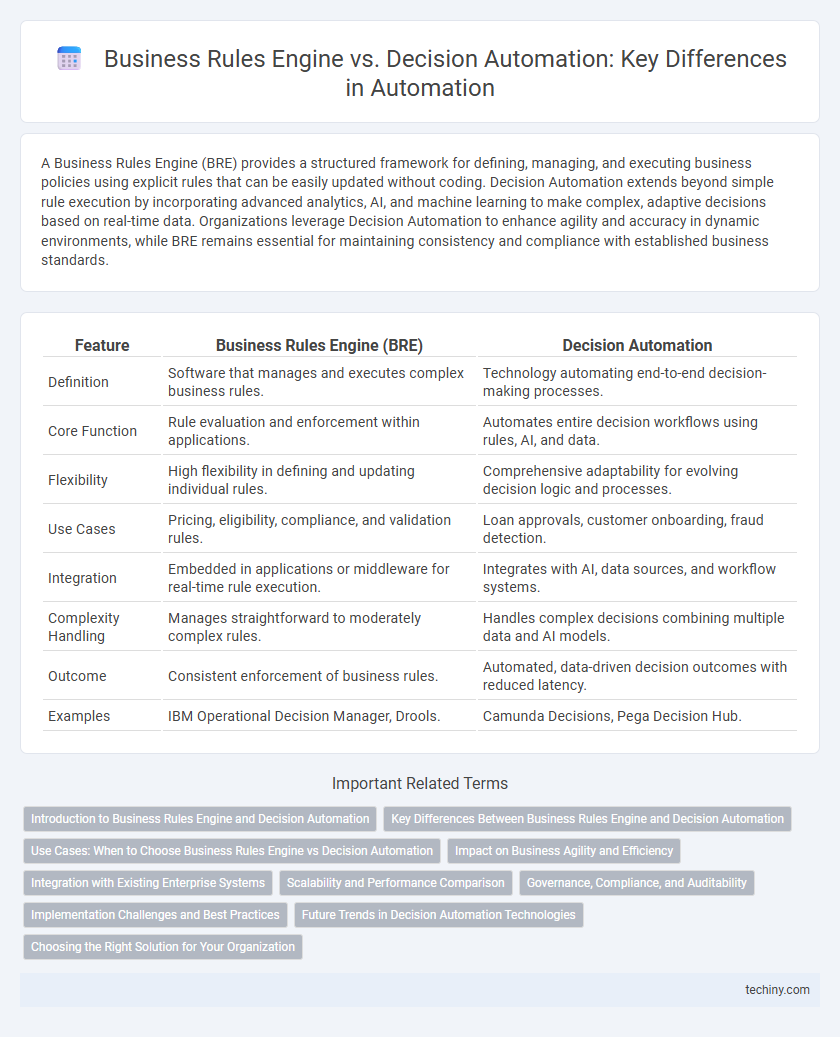A Business Rules Engine (BRE) provides a structured framework for defining, managing, and executing business policies using explicit rules that can be easily updated without coding. Decision Automation extends beyond simple rule execution by incorporating advanced analytics, AI, and machine learning to make complex, adaptive decisions based on real-time data. Organizations leverage Decision Automation to enhance agility and accuracy in dynamic environments, while BRE remains essential for maintaining consistency and compliance with established business standards.
Table of Comparison
| Feature | Business Rules Engine (BRE) | Decision Automation |
|---|---|---|
| Definition | Software that manages and executes complex business rules. | Technology automating end-to-end decision-making processes. |
| Core Function | Rule evaluation and enforcement within applications. | Automates entire decision workflows using rules, AI, and data. |
| Flexibility | High flexibility in defining and updating individual rules. | Comprehensive adaptability for evolving decision logic and processes. |
| Use Cases | Pricing, eligibility, compliance, and validation rules. | Loan approvals, customer onboarding, fraud detection. |
| Integration | Embedded in applications or middleware for real-time rule execution. | Integrates with AI, data sources, and workflow systems. |
| Complexity Handling | Manages straightforward to moderately complex rules. | Handles complex decisions combining multiple data and AI models. |
| Outcome | Consistent enforcement of business rules. | Automated, data-driven decision outcomes with reduced latency. |
| Examples | IBM Operational Decision Manager, Drools. | Camunda Decisions, Pega Decision Hub. |
Introduction to Business Rules Engine and Decision Automation
Business Rules Engines (BRE) enable organizations to define, manage, and execute complex business logic by separating rules from application code, enhancing flexibility and compliance in automated workflows. Decision Automation leverages these engines alongside AI and data analytics to streamline decision-making processes, ensuring consistency and speed in operational tasks. Together, they empower businesses to adapt rapidly to changing regulations and market conditions while optimizing resource allocation.
Key Differences Between Business Rules Engine and Decision Automation
Business Rules Engine (BRE) primarily focuses on applying predefined, explicit rules to automate decision-making processes within static frameworks, enabling consistent rule execution across applications. Decision Automation integrates advanced data analytics, machine learning, and real-time data inputs to manage complex, dynamic decisions that evolve with changing conditions. While BRE excels in rule enforcement and compliance, Decision Automation drives adaptive outcomes by learning from data patterns and contextual factors, enhancing organizational agility and scalability.
Use Cases: When to Choose Business Rules Engine vs Decision Automation
Business Rules Engines excel in environments requiring consistent application of predefined rules, such as regulatory compliance, loan approvals, and pricing strategies. Decision Automation suits complex scenarios involving dynamic data inputs and adaptive learning, including fraud detection, personalized marketing, and customer segmentation. Choosing between them depends on the need for static rule enforcement versus intelligent, data-driven decision-making.
Impact on Business Agility and Efficiency
A Business Rules Engine (BRE) enhances business agility by enabling rapid updates to rules without changing underlying code, streamlining decision-making processes and reducing time-to-market. Decision Automation leverages advanced analytics and AI to automate complex decisions, improving efficiency by minimizing manual intervention and increasing accuracy. Combining BRE and Decision Automation leads to optimized workflows, faster adaptation to market changes, and sustained operational excellence.
Integration with Existing Enterprise Systems
Business Rules Engines (BREs) offer seamless integration with existing enterprise systems by leveraging predefined rule sets that enhance system interoperability and maintain legacy workflows. Decision Automation platforms extend this capability by incorporating AI-driven analytics and real-time data processing, ensuring adaptive decision-making across complex enterprise environments. Both solutions prioritize compatibility with ERP, CRM, and BPM systems to optimize operational efficiency and reduce integration costs.
Scalability and Performance Comparison
Business Rules Engines (BRE) offer high scalability through modular rule management but can face performance bottlenecks with complex, dynamic decision-making scenarios. Decision Automation platforms extend beyond static rules by leveraging AI and real-time data processing, achieving superior performance and adaptability in large-scale, fast-changing environments. Enterprises requiring rapid, scalable decision workflows benefit more from Decision Automation due to its integration of machine learning algorithms and event-driven architectures.
Governance, Compliance, and Auditability
Business Rules Engine (BRE) offers a structured framework for implementing governance by codifying compliance policies into transparent, auditable rules that ensure consistent decision-making. Decision Automation integrates these rules with real-time data analytics and machine learning, enhancing auditability through dynamic decision tracking and contextual compliance validation. Both approaches support regulatory adherence, but BRE emphasizes rule clarity and traceability, while Decision Automation prioritizes adaptive governance and comprehensive audit trails.
Implementation Challenges and Best Practices
Implementing a Business Rules Engine (BRE) often faces challenges such as rule complexity management, ensuring rule consistency, and integrating with legacy systems, requiring a robust governance framework and continuous rule validation. Decision Automation demands handling diverse data sources, maintaining transparency in automated decisions, and ensuring compliance with regulatory standards, making thorough testing and iterative deployments essential best practices. Both approaches benefit from stakeholder collaboration, clear documentation, and modular architecture to enhance scalability and adaptability in dynamic business environments.
Future Trends in Decision Automation Technologies
Future trends in decision automation technologies emphasize enhanced AI integration, enabling systems to analyze complex data patterns and execute dynamic business decisions with minimal human intervention. Advances in machine learning algorithms and natural language processing are driving more adaptive and context-aware decision automation solutions, improving accuracy and responsiveness. The rise of cloud-based platforms and edge computing further accelerates real-time decision-making capabilities, supporting scalable and flexible automation across diverse industry applications.
Choosing the Right Solution for Your Organization
Business Rules Engines (BRE) offer structured rule management ideal for organizations needing clear, consistent policy enforcement, while Decision Automation integrates AI and machine learning for dynamic, data-driven outcomes. Evaluating factors such as complexity of decisions, volume of transactions, and scalability requirements is essential when selecting between BRE and Decision Automation. Aligning the solution with organizational goals, existing IT infrastructure, and future growth ensures optimal efficiency and competitive advantage.
Business Rules Engine vs Decision Automation Infographic

 techiny.com
techiny.com